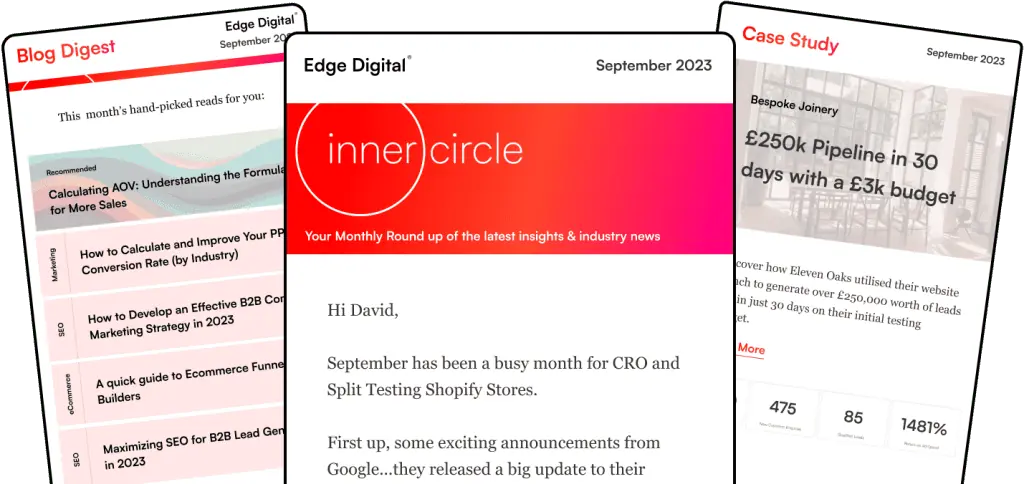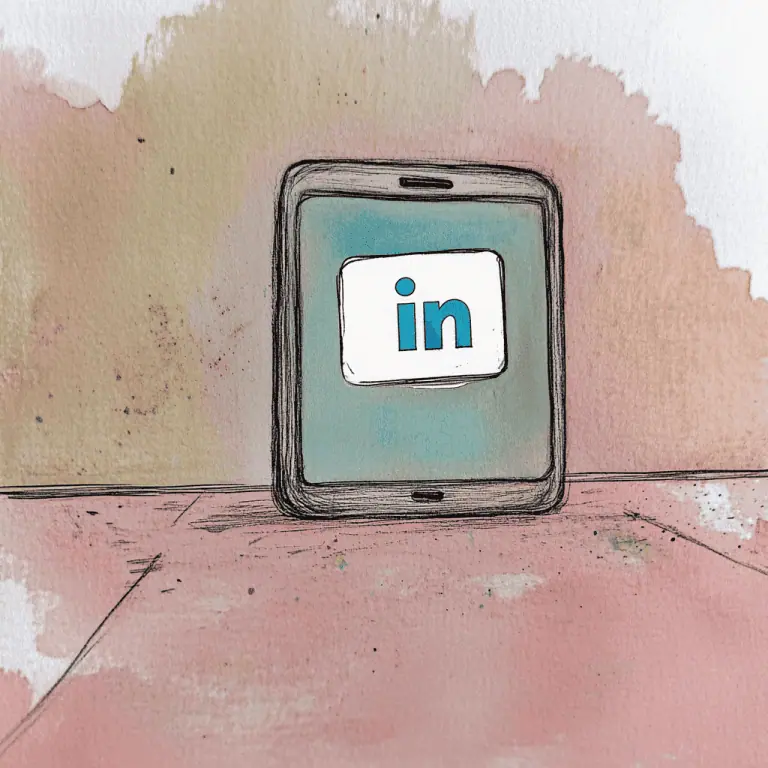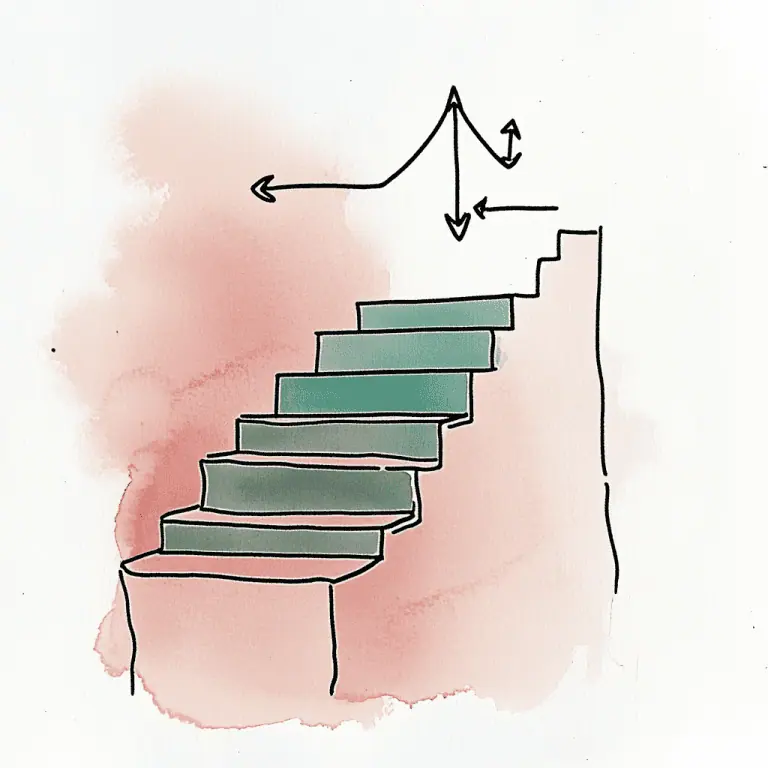Imagine the power of transforming untouched prospects into loyal, long-term customers through a streamlined process that maximizes your sales and marketing efforts. By addressing the needs and questions of each potential customer, you can significantly influence their decision-making and enhance their experience along the sales funnel. In this comprehensive guide, we will delve into the world of sales funnels and reveal how to unlock their full potential for your business success. Additionally, we will provide access to a free sales funnel template to help you visualize and manage your sales process.
Key Takeaways
Sales funnels are essential for successful conversion, allowing businesses to target their desired audience and optimize conversions.
Components of an effective sales funnel include lead generation strategies, engaging and nurturing leads, converting leads into customers, addressing the needs of potential customers, mapping out stages in the sales funnel process and optimizing performance metrics.
Tools such as CRM systems, marketing automation platforms & analytics tools can be used to build a successful sales funnel that drives long-term revenue growth.

Understanding Sales Funnels: The Key to a Successful Sales Funnel
A sales funnel serves as a guiding force, steering prospects from awareness to conversion. This strategic tool forms the bedrock of a successful sales and marketing strategy, optimizing your sales process. Crafting a sales funnel that resonates with your target audience allows you to engage and nurture potential customers effectively, steering them through every stage of the sales process: the top, middle, and bottom of the funnel.
Addressing the needs and questions of potential customers is essential to enhance their experience along the sales funnel.
What attributes make a sales funnel indispensable for business success? It’s simple: sales funnels help you:
Understand your audience
Create tailored marketing campaigns
Convert prospects into loyal customers
Provide a framework for your sales team to follow, ensuring a streamlined and efficient sales process
Understanding and optimizing the sales funnel is crucial for achieving sales success. So, if you’re looking to boost your sales performance and create a successful sales funnel, read on.
What is a Sales Funnel?
A marketing funnel is a graphical representation of the customer journey, breaking down the sales funnel process into distinct phases to optimize sales and marketing efforts. The stages of a sales funnel typically include top, middle, and bottom. By mapping out these stages and creating their own sales funnel, businesses can effectively target their desired audience, engage potential leads, and ultimately improve conversions and revenue.
Comprehending the stages of a sales funnel paves the way for a roadmap to success. This roadmap allows you to visualize the journey your potential customers take, from becoming aware of your product or service to making a purchase. By focusing on each stage of this journey, you can develop a successful sales funnel that not only increases conversions but also fosters long-term customer relationships.
Why Sales Funnels Matter
Sales funnels are crucial for business success because they help you target the right audience, nurture leads, and ultimately increase conversions and revenue. By learning how to create a sales funnel that effectively guides prospects through the customer journey, you can ensure that your marketing efforts are focused on the right people, at the right time, with the right message.
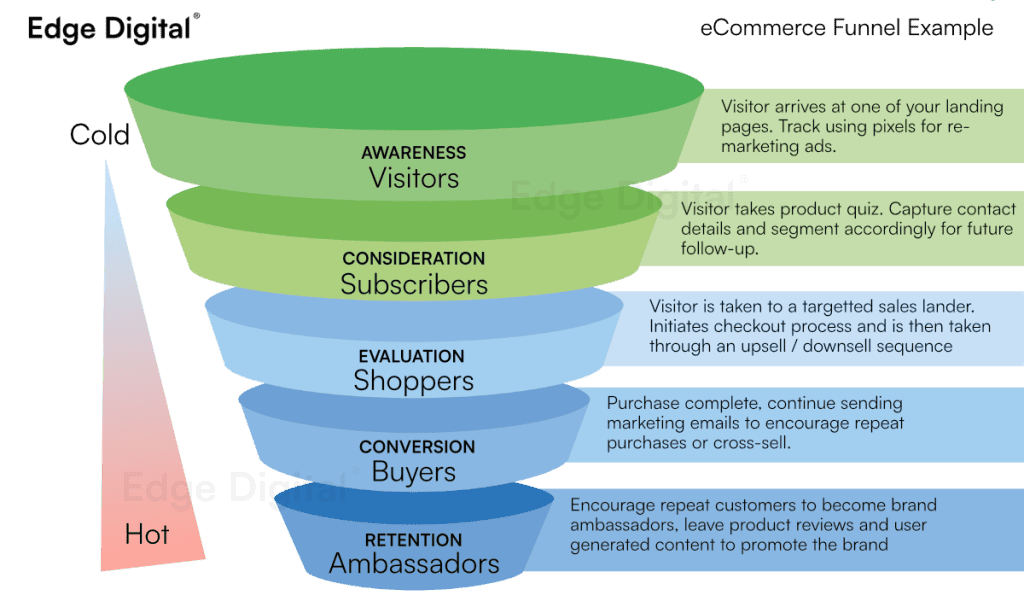
Additionally, sales funnels provide the opportunity to:
Pinpoint improvement areas in your sales process
Facilitate data-driven decisions and the optimization of marketing strategies
Understand where your prospects are in the funnel
Tailor your messaging and offers to their specific needs
Increase the likelihood of conversion
Boost your bottom line
Address the needs and questions of potential customers to enhance their decision-making process
Components of an Effective Sales Funnel
An effective sales funnel consists of three core components: lead generation strategies, engaging and nurturing leads, and converting leads into customers. Each component plays a vital role in guiding prospects through the customer journey and ensuring a smooth and efficient sales process. Addressing the needs and questions of potential customers throughout the sales funnel is crucial for nurturing relationships and positively influencing their decision-making.
Mastering these components and weaving them into your sales funnel can notably enhance your sales performance and fuel revenue growth. In the sections that follow, we’ll explore each of these components in greater detail, providing you with actionable insights and strategies for building a high-performing sales funnel.
Lead Generation Strategies
The first component of an effective sales funnel is lead generation. This involves attracting potential customers to your business through various strategies such as content marketing, social media, and targeted ads. By creating content that resonates with your target audience and using platforms where they’re most likely to engage, you can generate high-quality leads that are more likely to convert.
Upon attracting these leads, capturing their contact information becomes essential for ongoing engagement and nurturing throughout the sales process. This can be achieved through various methods, such as offering valuable content in exchange for their email address or providing exclusive offers and promotions. By focusing on lead generation strategies that align with your target audience’s interests and needs, you can build a solid foundation for your sales funnel and turn prospects into paying customers, driving long-term business success.
Engaging and Nurturing Leads
The second component of an effective sales funnel involves engaging and nurturing leads. This means providing valuable content, building trust, and maintaining communication throughout the sales funnel stages. Addressing the needs and questions of potential customers is crucial to build trust and maintain engagement. By offering tailored content that speaks to your prospects’ pain points and needs, you can establish your brand as a trusted authority and keep your audience engaged.
One effective strategy for nurturing leads is email marketing. By sending personalized emails that offer valuable insights, tips, and promotions, you can keep your prospects interested and engaged with your brand. Additionally, maintaining regular communication with your leads helps build trust and fosters a strong relationship with your audience, increasing the likelihood of conversion.
In the end, the art of engaging and nurturing leads drives sales and assures the longevity of your sales funnel’s success, so make sure to keep your strategies effective.
Converting Leads into Customers
The final component of an effective sales funnel is converting leads into customers, which involves addressing the specific needs of potential customers. This is a crucial step in the sales pipeline. It involves using persuasive messaging, tailored offers, and strong calls-to-action to encourage prospects to make a purchase. By addressing your audience’s pain points and offering solutions that cater to their specific needs, you can increase the likelihood of conversion and drive revenue growth. In this process, sales reps play a vital role in closing deals and ensuring customer satisfaction.
To optimize conversions, it’s essential to continually test and refine your messaging, offers, and calls-to-action. By analyzing your sales funnel performance and identifying areas for improvement, you can make data-driven decisions that enhance your overall conversion rate and boost your bottom line.
To sum it up, the conversion of leads into customers is the ultimate aim of any sales funnel, and perfecting this component is critical for enduring business success.
Mapping Out Your Sales Funnel Stages
Charting your sales funnel stages is crucial for comprehending and enhancing the customer journey. By breaking down the sales process into distinct stages, such as top of the funnel (awareness), middle of the funnel (interest and trust), and bottom of the funnel (conversion), you can ensure that each stage is tailored to your prospects’ needs and preferences. Mapping out these stages helps in addressing the needs and questions of potential customers at each stage, ensuring a smoother and more effective sales process.
Grasping the specific goals and objectives of each stage empowers you to:
Design targeted marketing campaigns and sales strategies
Effectively shepherd prospects through the sales process
Optimize your sales funnel performance
Build stronger customer relationships
Drive long-term business growth
Top of the Funnel: Generating Awareness
At the top of the funnel, your primary goal is to generate awareness of your product or service among potential customers. This can be achieved through various strategies, such as content marketing, social media, and targeted ads. By creating content that resonates with your audience, you can drive traffic to your website, capture leads, and begin the process of nurturing them through the sales funnel.
It’s essential to continually test and refine your awareness-generating strategies to ensure that you’re reaching the right audience with the right message. By monitoring performance metrics, such as website visitors, social media engagement, and ad click-through rates, you can make data-driven decisions that improve your top-of-funnel performance and set the stage for a successful sales funnel.
Middle of the Funnel: Building Interest and Trust
In the middle of the funnel, your focus shifts from generating awareness to building interest and trust among your potential customers. This involves providing personalized content that addresses your audience’s pain points and needs, as well as engaging in regular communication through email marketing and other channels.
Addressing the needs and questions of potential customers is crucial to building interest and trust. By responding quickly and providing valuable information, you can positively influence their decision-making and enhance their experience along the sales funnel.
By building interest and trust, you can guide your prospects through the sales funnel and increase the likelihood of conversion. It’s important to continually monitor your middle-of-funnel performance, such as email open rates, click-through rates, and content engagement, to ensure that your strategies are resonating with your audience and driving them towards the next stage of the sales process.
Bottom of the Funnel: Driving Conversions
At the bottom of the funnel, your primary objective is to drive conversions by addressing any remaining needs or objections of potential customers. This involves offering tailored solutions and using persuasive calls to action to encourage action.
To optimize your bottom-of-funnel performance, it’s essential to continually test and refine your messaging, offers, and calls-to-action. By analyzing your conversion rates, customer feedback, and other key metrics, you can identify areas for improvement and make data-driven decisions that enhance your overall sales funnel performance.
In summary, driving conversions is the ultimate goal of any sales funnel, and mastering this stage is key to long-term business success.
Sales Funnel Metrics and Optimization
Sales funnel metrics and optimization serve a pivotal role in gauging your sales funnel performance and instituting data-driven enhancements. By tracking key metrics such as conversion rates, lead generation, and customer acquisition costs, you can gain valuable insights into the effectiveness of your sales funnel and identify areas for improvement.
Tracking metrics related to potential customers can help optimize the sales funnel by addressing their needs and questions, ultimately enhancing their experience and decision-making process.
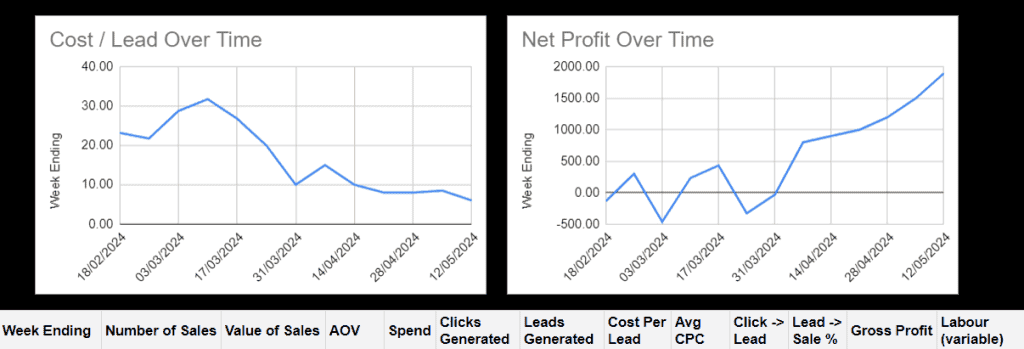
Understanding Key Metrics at every stage is critical for understanding performance, and being able to identify issues before they become bigger problems
Analyzing your sales funnel performance data empowers you to:
Make informed decisions regarding the efficacy of various strategies and tactics
Identify areas requiring further optimization
Improve your sales funnel performance
Drive long-term business growth through a more efficient and targeted sales process.
Measuring Sales Funnel Performance
Measuring your sales funnel performance involves tracking key metrics related to potential customers, such as conversion rates, lead generation, and customer acquisition costs. By monitoring these metrics, you can gain valuable insights into the effectiveness of your sales funnel and identify areas for improvement.
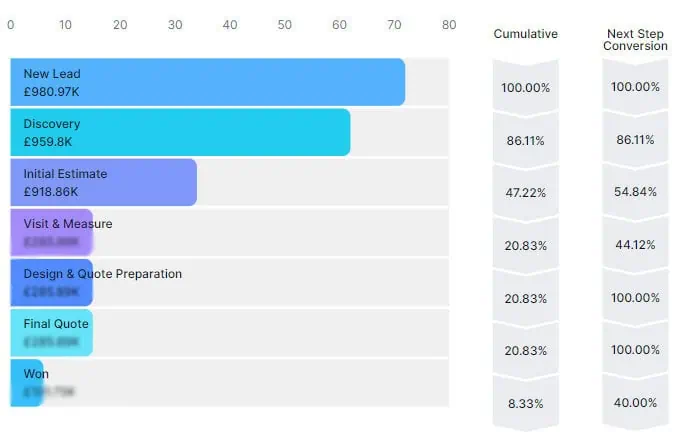
A real example from a client where all tracking is considered at every single step. If you don’t have visibility on where your funnel is breaking down, you cannot make the changes necessary
To effectively measure your sales funnel performance, it’s essential to utilize the right tools and resources. Some popular options include:
Improvado
Kissmetrics
Google Analytics
By leveraging these tools, you can gain a deeper understanding of your sales funnel performance and make data-driven decisions that enhance your overall sales and marketing efforts.
Optimizing Your Sales Funnel
Optimizing your sales funnel involves analyzing your performance data, identifying areas for improvement, and implementing changes to enhance your results. By continually refining your sales funnel strategies and tactics, you can create a more efficient and targeted sales process that drives conversions and revenue growth. Addressing the needs and questions of potential customers is crucial in this process, as it helps nurture relationships and positively influences their decision-making.
Some strategies for optimizing your sales funnel include testing different marketing campaigns, refining your messaging and offers, and improving your calls-to-action. By making these data-driven changes, you can ensure that your sales funnel is operating at peak performance and driving maximum results for your business.
Real-Life Sales Funnel Examples
Now that we’ve explored the components and strategies of effective sales funnels, let’s take a look at some real-life examples that demonstrate how businesses can successfully guide prospects through the customer journey. Addressing the needs and questions of potential customers is clearly demonstrated in these examples, showcasing how nurturing relationships can positively influence decision-making.
Examining these examples offers valuable insights into how diverse industries and organizations utilize sales funnels to propel conversions, augment revenue, and secure enduring business success. These examples serve as inspiration and guidance for building your sales funnel and maximizing its potential.
Example 1: A SaaS Company
In this example, a SaaS company specializing in marketing automation utilizes the following strategies to guide potential customers from awareness to conversion:
Targeted ads on Facebook to reach its designated audience
Engaging content on its website to capture leads
Personalized offers to nurture leads and encourage conversion
The company’s sales funnel begins with multiple Facebook ads targeting its designated audience, driving traffic to its website and capturing leads.
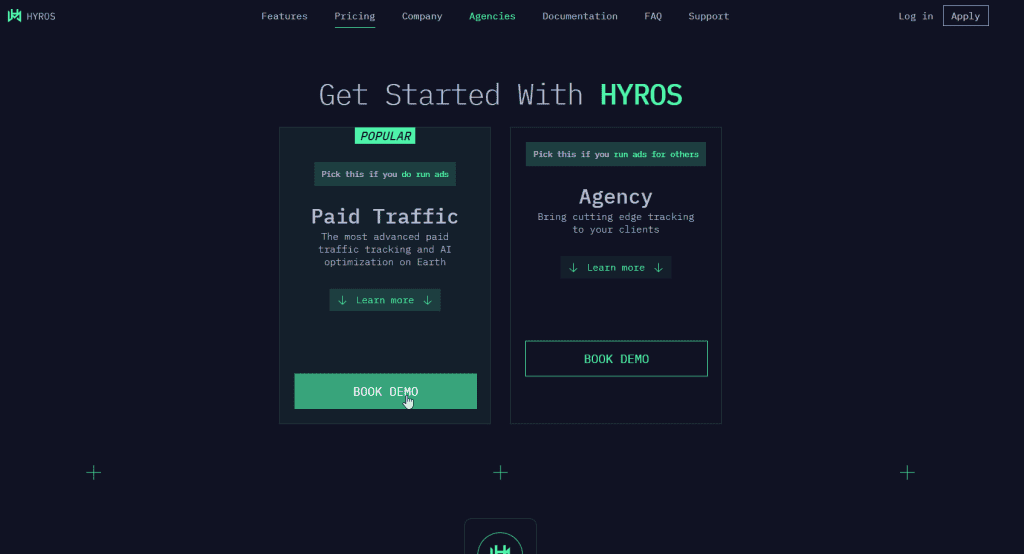
Hyros, a SaaS company in the tracking and attribution space have multiple entry points into their sales funnel based on industry and marketing angle.
As prospective customers move through the sales funnel, the SaaS company’s sales teams nurture them with tailored content that addresses their specific challenges and needs throughout the sales cycle. This helps build trust and interest, ultimately leading to conversions and long-term customer relationships.
By leveraging targeted ads, engaging content, and personalized offers, this SaaS company demonstrates the power of a well-structured sales funnel.
Example 2: An E-commerce Store
In the case of an e-commerce store, the sales funnel leverages social media, email marketing, and tailored promotions to attract and nurture potential customers, ultimately driving sales. The store attracts potential customers through engaging social media content and targeted ads and captures their contact information through enticing offers and promotions.
The e-commerce store then nurtures these leads, including existing customers, through personalized email campaigns, offering valuable content and special deals to maintain their interest and engagement. By building trust and fostering strong customer relationships, the store increases the likelihood of conversion and drives long-term revenue growth.
This example showcases how an e-commerce store can successfully utilize a sales funnel to guide prospects through the customer journey and achieve business success.
Tools and Resources for Building Your Sales Funnel
To craft a successful sales funnel, having the appropriate tools and resources at your disposal is crucial. These include Customer Relationship Management (CRM) systems, marketing automation platforms, and analytics and tracking tools. By leveraging these tools, you can effectively manage your sales funnel, optimize its performance, and drive long-term business growth.
The right tools and resources can help address the needs and questions of potential customers, ensuring their experience is positive and their decision-making process is well-supported.
In the following sections, we’ll explore each of these tools and resources in more detail, providing you with actionable insights and recommendations for building and optimizing your sales funnel.
CRM Systems
CRM systems play a crucial role in managing potential customers, tracking their activities, and automating sales processes. By utilizing a CRM system, you can gain valuable insights into your sales funnel performance, identify areas for improvement, and make data-driven decisions that enhance your sales process.
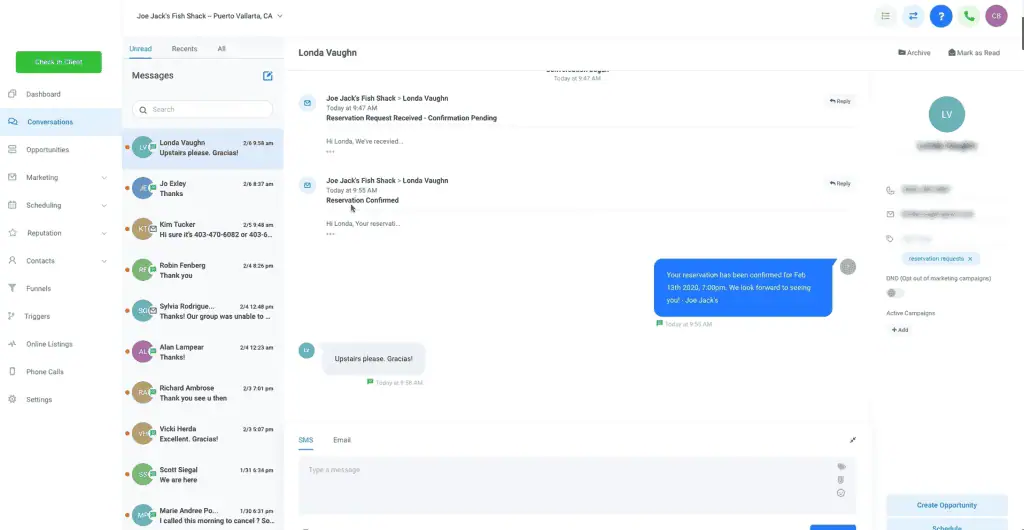
Go High Level is a great system if you’re new to CRM.
Some popular CRM systems include GoHighLevel, Salesforce, HubSpot, and Zoho CRM. These platforms offer a range of features, such as contact management, workflow automation, and sales forecasting, that can help you streamline your sales funnel and drive conversions. By leveraging a CRM system, you can ensure that your sales funnel is operating at peak performance and delivering maximum results for your business.
Marketing Automation Platforms
Marketing automation platforms are essential for streamlining your marketing efforts, nurturing potential customers, and measuring campaign performance. These platforms enable you to create automated workflows that deliver targeted content and messages to leads based on their behavior and interests, helping to move them through the sales funnel and increase the likelihood of conversion.
Popular marketing automation platforms include:
Marketo
By leveraging these tools, you can optimize your marketing campaigns, track key performance metrics, and make data-driven decisions that enhance your overall sales and marketing efforts.
In summary, marketing automation platforms are a vital resource for building and optimizing your sales funnel.
Analytics and Tracking Tools
Analytics and tracking tools provide valuable insights into potential customers’ behavior, sales funnel performance, and opportunities for optimization. By monitoring key metrics such as website visitors, social media engagement, and ad click-through rates, you can gain a deeper understanding of your sales funnel performance and make data-driven decisions that improve your results.
Examples of effective analytics and tracking tools include:
Microsoft Clarity
Google Analytics
Kissmetrics
Funnelytics
Hotjar
By leveraging these tools, you can gain valuable insights into your sales funnel performance, identify areas for improvement, and implement changes that enhance your overall sales process.
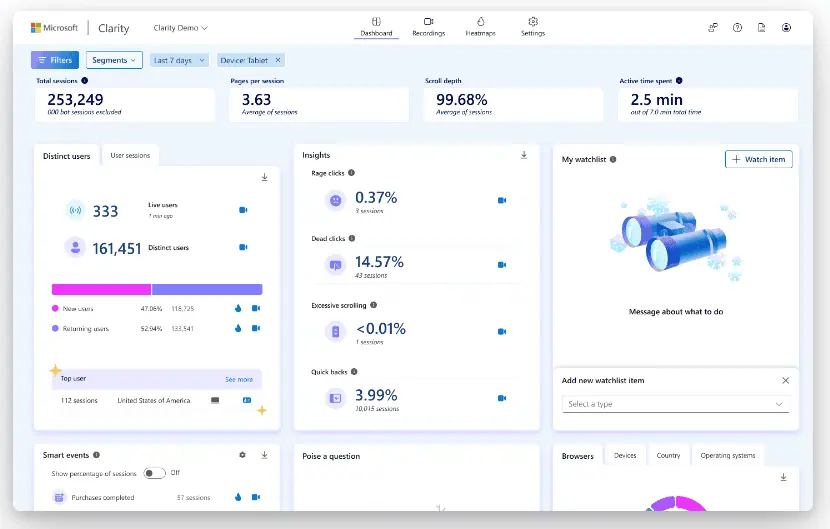
Microsoft Clarity is a hidden gem. Enables session recording, heat mapping and AI insights – All features are FREE forever.
To conclude, analytics and tracking tools are indispensable for optimizing your sales funnel and propelling enduring business growth.
Summary
In this comprehensive guide, we’ve explored the key components of a successful sales funnel, discussed strategies for optimizing performance, and provided real-life examples of how businesses can effectively guide prospects through the customer journey. With the right tools and resources at your disposal, you can build a high-performing sales funnel that drives conversions, increases revenue, and fosters long-term business success. Now it’s time to put these insights into action and unlock the full potential of your sales funnel. Addressing the needs and questions of potential customers throughout the sales funnel is crucial for nurturing relationships and enhancing their decision-making process.
Frequently Asked Questions
What are the 4 stages of the sales funnel?
The 4 stages of the sales funnel typically include Awareness, Interest, Decision and Action. At each stage, companies work to increase prospects’ knowledge of their product or service, build interest in what they offer, help them make an informed decision and eventually prompt action.
Do sales funnels really work?
Yes, sales funnels do work. They provide key insights into customer needs and challenges that allow organizations to better allocate resources for converting leads into sales, resulting in increased revenue over time.
What are the main components of an effective sales funnel?
Lead generation, engaging and nurturing leads, and converting leads into customers are the main components of an effective sales funnel.
What strategies can be employed to generate leads?
Lead generation strategies such as content marketing, social media, and targeted ads can be utilized to generate leads.
How can I nurture leads through my sales funnel?
Nurture leads through your sales funnel by providing valuable content, building trust, and keeping in contact with prospects.
